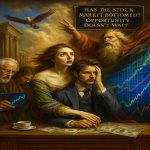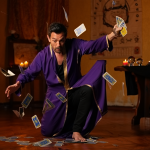
Start with the Question That Refuses to Die
May 8, 2025
What type of investor is Peter Lynch? It’s a question that echoes through trading floors, college lecture halls, and the private offices of restless portfolio managers who fear irrelevance more than failure. Lynch’s name carries the weight of legend, yet also the shadow of an era—one foot in the electric past of Wall Street and the other in the algorithmic maelstrom of today. The question is not merely academic; it is existential. Does his archetype still matter in a world where neural networks dream in candlesticks, and financial media amplifies the herd’s heartbeat to a fever pitch?
Let’s begin at the living edge—where Lynch’s methods, market mass psychology, and emergent strategies collide in a multidimensional arena. The answer, if it exists, will not be found in the tidy boundaries of style boxes or ETF tickers. It will be found in paradox, in the strange attractors of human behaviour, and in the creative synthesis of old wisdom and new technology.
Standing Alone in the Crowd: Mass Psychology and the Lynch Paradox
To ask what type of investor is Peter Lynch is first to encounter a paradox. Lynch was an obsessive researcher, a man who devoured balance sheets like detective novels, yet he was also a populist—urging regular people to “buy what you know.” This is the first Lynchian contradiction: the belief that the ordinary is extraordinary, if you look hard enough.
But markets are not rational. They are living, breathing networks of emotion, feedback, and mimicry. The panic of the crowd, the euphoria of the masses, the stubbornness of the lone wolf—these are not random. They are quantifiable, repeatable, and—at their extremes—predictive. Lynch understood this. He saw through the layers of narrative and hype to the behavioural undercurrents that drove them. When everyone ran for the exits, Lynch prowled the empty aisles, searching for what the stampede had overlooked.
The behavioral finance revolution—anchored by Kahneman, Tversky, and Thaler—arrived after Lynch’s heyday, but he was its living proof. He knew that value is created at the edge, when collective psychology overshoots its mark. The 1987 crash, the dot-com mania, the mortgage meltdown: each a case study in mass delusion and the opportunities it breeds for those who can stand apart.
Technical Analysis: From Charts to Consciousness
Here’s where the question—what type of investor is Peter Lynch?—gets interesting. Lynch was no chartist in the classic sense. He preferred the pulse of a company’s sales floor to the abstract undulations of a price chart. Yet, in today’s market, technical analysis is not just a tool; it’s a living, adaptive organism. Indicators like the WaveTrend Oscillator, Neural Network Oscillators, and Adaptive Moving Averages are no longer static—they learn, mutate, and sometimes hallucinate the future.
TradingView, with its constellation of machine-learning-based indicators, has given technical analysis a new dimension. Patterns emerge from the noise—head and shoulders, triangles, mean reversions—each a ghostly echo of collective expectation. But here’s the paradox: these patterns only exist because enough people believe in them. The chart becomes a mirror for mass psychology, a predictive hallucination, and the feedback loop tightens.
If Lynch were starting today, would he ignore these tools? Hardly. He would dissect them, ask what beliefs they encode, and use them not to predict prices, but to map the contours of fear and greed. The edge, as always, is found at the intersection: where fundamental conviction meets technical confirmation, and both are filtered through the lens of human behavior.
Synthesis: Physics, Myth, and the Art of Stockpicking
To answer what type of investor is Peter Lynch is to understand that investing is not a closed system. It is a vector field—forces intersect, ripple, and amplify in unpredictable ways. Physics teaches us that the observer changes the observed; so too in markets, where the act of buying or selling reshapes the very reality being measured.
In mythology, the hero ventures into the unknown, faces monsters, and returns with wisdom. Lynch’s “tenbagger” philosophy is mythic at its core: seek out neglected, misunderstood companies, brave the skepticism of the crowd, and emerge triumphant. But not every journey ends in gold. Sometimes, the monsters win. The myth endures because of, not despite, its failures.
This is the essence of the Lynch approach—a willingness to leap across domains, to embrace the irrational, the overlooked, the paradoxical. He synthesized hard numbers with soft intuition, macro trends with micro insights, and always with a sense of humor that cut through the sanctimony of Wall Street.
Edge Cases: Where Lynch Meets the Machines
Let’s be honest: the centre of the bell curve is where mediocrity lives. Lynch thrived at the edges—those rare moments when a shoe company, a waste management firm, or a regional bank exploded into relevance. Today, the edges are populated by algorithms, quant funds, and retail stampedes coordinated on social media. The GameStop saga was a paroxysm of edge-case investing: a meme, a short squeeze, a rebellion. It was also a reminder that the market’s “rules” are always provisional.
So, what type of investor is Peter Lynch? He was an edge-case hunter, long before “edge” became a quant buzzword. He understood that the best returns come not from safe consensus, but from intelligent risk-taking at the margins. The machines, for all their power, still struggle with the messy, nonlinear nature of human psychology. That is the last refuge of the human investor—the ability to see pattern in chaos, to hold conviction when the data is inconclusive.
Emergence: When the Parts Become Something More
The sum is greater than the parts. This is the law of emergence, in physics and in markets. Lynch’s genius was not in any single trait—his research, his optimism, his wit—but in how these traits interacted, evolved, and gave rise to something unique. His approach was not static; it was a living strategy that adapted to new information, new environments, and new risks.
Today, the market is more complex, faster, and less forgiving. But the principles of emergence endure. The best investors—human or machine—are those who can synthesize, adapt, and reinvent. Lynch matters not because his methods can be copied, but because his philosophy is anti-fragile—it grows stronger in the face of uncertainty, contradiction, and change.
Does Lynch Still Matter in a Machine World?
It’s easy to dismiss Lynch as a relic, a product of a simpler, slower Wall Street. But such cynicism is a mask for fear—the fear that human judgment is obsolete. In truth, Lynch’s approach is more relevant than ever. When everyone is chasing the same factor models and crowding into the same trades, the opportunity is at the edge. To ask what type of investor is Peter Lynch is to remind ourselves that markets are still governed by surprise, by anomaly, by the irrepressible weirdness of human nature.
The best strategies today fuse Lynchian curiosity with machine precision. They blend psychological insight with technical acumen, and they treat uncertainty not as a threat but as an invitation. The investor who can hold paradox, who can dwell in the unknown, who can see the emergent pattern before it is obvious—that is the true heir to Lynch’s legacy.
Finale: The Investor as Mythmaker and Maverick
So, what type of investor is Peter Lynch? He is the mythmaker, the edge-dweller, the synthesiser of opposites. He is the investor who believes that the world is stranger—and more full of opportunity—than the cynics admit. His relevance endures not because he offers a formula, but because he offers a philosophy: embrace uncertainty, hunt for anomalies, and never stop learning.
As the machines grow smarter and the data flows faster, the Lynchian spirit—curious, contrarian, and creative—is a reminder that investing is not just about numbers. It is about possibility, about the interplay of psychology, narrative, and chance. The future belongs to those who can dance at the intersection, who can leap between domains, and who are unafraid to ask the questions that never die.










